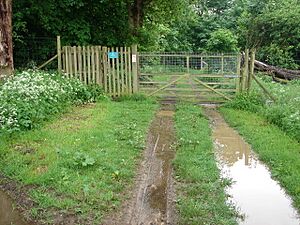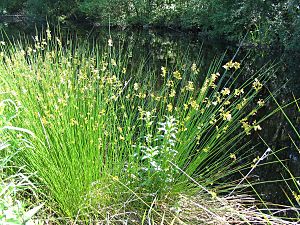Seacourt facts for kids
Quick facts for kids Seacourt |
|
|---|---|
 Woodland entrance in the former parish |
|
| Civil parish |
|
| District | |
| Shire county | |
| Region | |
| Country | England |
| Sovereign state | United Kingdom |
| EU Parliament | South East England |
Seacourt is a place in Oxfordshire, England, near the city of Oxford. It used to be a village, but now it's a deserted medieval village (DMV). This means it was a village that people lived in during the Middle Ages, but then everyone left, and it became empty.
Today, most of the old village site is under the Oxford Western By-pass (the A34). It's about 0.3 miles (0.5 km) south of the Seacourt/Hinksey Stream crossing.
Contents
What's in a Name? The Story of Seacourt

The name Seacourt has a long history! The very first time we see it written down was around the year 957 AD. Back then, it was called " Seofecanwyrthe " .
The middle part, " fekan " , was a word used to describe the Danish people who lived there before. But the real name was " Seof..wyrthe " .
This old name probably came from two older words:
- An Old Danish word, ' sef ' , which means "sedge" or "rush" (types of grassy plants).
- An Old English word, ' worðig ' , which means "an enclosed farm" or "homestead."
So, the name likely meant something like "the farm where sedges or rushes grow."
In 1086, when the Domesday Book was made (a big survey of England), the name was written as Seuaworde.
Meaning of the Name
The name Seacourt might mean:
- "Seavy enclosure" (an area fenced off where "seaves" grow).
- "Enclosure where seaves grow."
"Seaves" are old words for certain types of sedge and rush plants. These plants often grow in wet places, like ditches or waterlogged ground.
Archaeologists (people who study old things) have found signs that the first settlement here had fenced-off areas and wooden sheds for animals. This fits with the idea of a "seavy enclosure" or farm.
How the Name Changed Over Time
The name Seacourt changed a lot through the years:
- Around 957, it was Seof..wyrthe (from Old Danish sef).
- In the 10th century, it was Seove..curt (using the local word seave).
- By the 13th century, it was sometimes Sevek..worth.
- In the 15th century, it was called Seck worth.
- And by the 20th century, it became Sea..court.
Seacourt's Name Lives On
Even though the village is gone, the name Seacourt is still used in the area around Botley and Oxford:
- The Seacourt Stream is a local waterway.
- There's a place called Seacourt Tower.
- And a large car park called Seacourt Park and Ride.
Who Owned Seacourt? The Manor's History
The first record we have of Seacourt is from 955. At that time, King Eadwig gave 20 "hides" of land (an old way to measure land) in Seacourt, Hinksey, and Wytham to a group of monks called the Benedictine Abingdon Abbey.
By 1086, when the Domesday Book was written, the Abbey had let a non-religious person (a "lay tenant") manage the land as the lord of the manor of Seacourt.
Over the centuries, the ownership of Seacourt changed many times. It was passed down through families, sold, and even split into different parts. Eventually, in 1469, a man named Sir Richard Harcourt started buying up all the different shares. By the time he died in 1486, he owned all of Seacourt and the nearby manor of Wytham. After that, Seacourt and Wytham stayed together, and by 1546, Seacourt was considered part of the Wytham manor.
The Village Church
Seacourt had its own parish church by the year 1200. It was dedicated to Saint Mary. The church was given to the prioress (the head nun) of the Benedictine Studley Priory, Oxfordshire.
Sadly, in 1439, it was reported that the church building had fallen down. Later, in 1539, during the time when King Henry VIII closed down many monasteries (the Dissolution of the Monasteries), Studley Priory gave its lands, including those in Seacourt, to the King. The King then sold these lands in 1540.
Life in Seacourt: Mills, Houses, and Pilgrims
Seacourt had two watermills, which used the power of water to grind things. In the 12th century, they were used as corn mills (to grind grain). Later, in the early 13th century, they were used as "fulling mills." Fulling was a process used to clean and thicken wool cloth.
The first houses in Seacourt were made of wood. But in the 13th century, a new street was built, running north to south. Along this street, new houses were built using stone.
The old road between Eynsham and Oxford used to go right through Seacourt. This was important because a special healing well at Binsey was a popular place for pilgrimage (a journey to a holy place). Binsey was just across the Seacourt Stream, so many pilgrims would stay in Seacourt when they visited the well. It's said that Seacourt even had 24 inns (like hotels) to host all these visitors!
However, by 1439, the same report that said the church had collapsed also mentioned that almost all the houses in the village were ruined and empty. This shows that the village was already declining.
By the time of the historian Anthony Wood (who lived from 1632 to 1695), you could still see the ruins of Seacourt. Today, there are no buildings left, just some small bumps in the fields where the village once stood. Archaeologists have dug up the site several times, in 1937-1939 and again in 1958-1959, to learn more about the deserted village.
In 1924, there were two farms south of the old village. One was called Seacourt Farm, which lasted until 1963.
Seacourt was once its own small area. In 1858, it officially became a civil parish (a small local area). But on April 1, 1900, it was joined with the nearby parish of Wytham. In 1891, only 23 people lived in the Seacourt parish.
|

